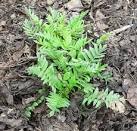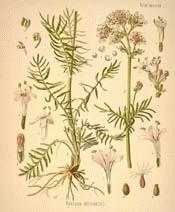
The plant is found throughout Europe and Northern Asia, and is common in England in marshy thickets and on the borders of ditches and rivers, where its tall stems may generally be seen in the summer towering above the usual herbage, the erect, sturdy growth of the plant, the rich, dark green of the leaves, their beautiful form, and the crowning masses of light-coloured flowers, making the plant conspicuous.
Two species of
Valerian,
Valeriana officinalis and
V. dioica, are indigenous in Britain, while a third,
V. pyrenaica, is naturalized in some parts. The genus comprises about 150 species, which are widely distributed in the temperate parts of the world.

In medicine, the root of
V. officinalis is intended when Valerian is mentioned. It is supposed to be the
Phu (an expression of aversion from its offensive odour) of Dioscorides and Galen, by whom it is extolled as an aromatic and diuretic.
It was afterwards found to be useful in certain kinds of epilepsy. The plant was in such esteem in mediaeval times as a remedy, that it received the name of All Heal, which is still given it in some parts of the country.

No comments:
Post a Comment